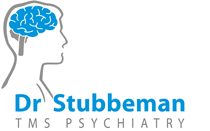
New Therapy Relies on Electromagnetic Pulses to Treat Depression
STAFF WRITER | The Record | November 5, 2014
© 2015 North Jersey Media Group All Rights Reserved.
A new treatment that relies on sending magnetic pulses into the brain may provide a beacon of hope for those suffering from depression, especially if other types of treatment, including medication, have failed in the past.
Called transcranial mag-netic stimulation (TMS), it involves the holding of an electromagnetic coil against the forehead near the area of the brain scientists believe influences mood regulation. Short electromagnetic pulses are then sent through the coil, stimulating nerve cells and increasing activity in parts of the brain that are underactive during depression, said Dr. David Rosenfeld, a senior psychiatrist and co-owner of Neuropsychiatric Associates of Northern NJ in Ridgewood.
Rosenfeld began offering the treatment, which is typically broken into 40-minute sessions five times a week for six weeks, in December 2013. About a half-dozen facilities (including his) offer the treatment in North Jersey.
“It’s like an electromagnetic massage of the brain, roughly analogous to a sore back that’s being stimulated by a masseuse,” Rosenfeld said. He described the pulsing as a series of knocks that sounds “almost like a woodpecker tapping,” but added that it’s “very gentle.”
The National Institute of Mental Health (NIMH) noted that patients may feel discomfort in the spot where the magnet is placed, and mild headaches or brief lightheadedness may follow. Although it’s possible that the treatment could produce a seizure, documented occurrences are rare, the agency said.
‘No radiation’
“There’s no radiation, and you’re not taking any substance into the body, so you’re not causing systemic side affects,” Rosenfeld said.
It may be natural to compare TMS to electroconvulsive therapy (ECT) — once known as “electroshock” — but the doctor said that ECT actually administers a current that induces a seizure in the patient. Using the metaphor of rain in a garden, Rosenfeld said, TMS is like a light rainstorm; ECT is a full-on hurricane.
“It’s lots of stimulation, but it’s everywhere and it overwhelms the system,” he said. “It’s somewhat traumatic.”
Dr. Ye-Ming Sun, an assistant professor of psychiatry at the Newark-based Rutgers New Jersey Medical School, administers both treatments and said that TMS, which focuses only on increasing activity in the left prefrontal cortex, is, in fact, less harsh than ECT. Psychiatrists can perform the procedure themselves, he said, and anesthesia is not needed.
“The patients drive themselves here, they’re fully awake during the treatment, and when they leave, they drive away themselves,” he said.
He has treated about 40 patients over the past three years and has never seen side effects greater than a mild headache. Because of TMS’ narrow focus, it does not affect the part of the brain that has to do with memory, he said.
Rosenfeld currently has 25 patients who have undergone a total of about 750 treatments over the last year, and he feels TMS to be “pretty darn safe.” About half of those patients, he said, get a “significant benefit” from it.
‘It isn’t for everybody’
“For some patients it’s really wonderful,” he said. “There are some who failed to respond to medicine, and they have done very nicely. It’s not a panacea — it isn’t for everybody. But we’re getting 50 percent of those people to feel better in a meaningful way, and those are people who have not done well with other treatments.”
Sun, however, has found that by adjusting the parameters of the treatment (such as the duration) for each individual, TMS can be effective for up to 80 percent of his patients.
“The efficacy is much higher than what’s reported in [scientific] literature,” he said.
The practice was developed in 1985 and approved by the Federal Drug Administration in 2008 for treatment of major depression in patients who hadn’t responded to at least one antidepressant medication.
Dr. David G. Brock, medical director for Pennsylvania-based Neuronetics, a major producer of the TMS device, said that many insurance companies — as well as the majority of Medicare carriers — now cover the treatment, meaning that about 150 million Americans are eligible. That’s good news, because a treatment cycle can cost around $10,000.
He estimated that 20,000 individual cases have already been treated as TMS has moved more into the mainstream after years of being viewed as an experimental therapy.
“It’s increasing by leaps and bounds — it’s clearly established technology … and it works,” he said.
Rosenfeld said that there’s “good evidence” that patients reap the benefits from TMS for nearly a year afterwards, although Brock said that because of depression’s chronic nature, many need some sort of additional therapy, be it medication or additional “booster” sessions after.
In the future, Brock said, TMS could also be used to treat anxiety disorders, chronic pain, post-traumatic stress disorder and symptoms of Parkinson’s or Alzheimer’s.
“The sky is the limit,” he said.
